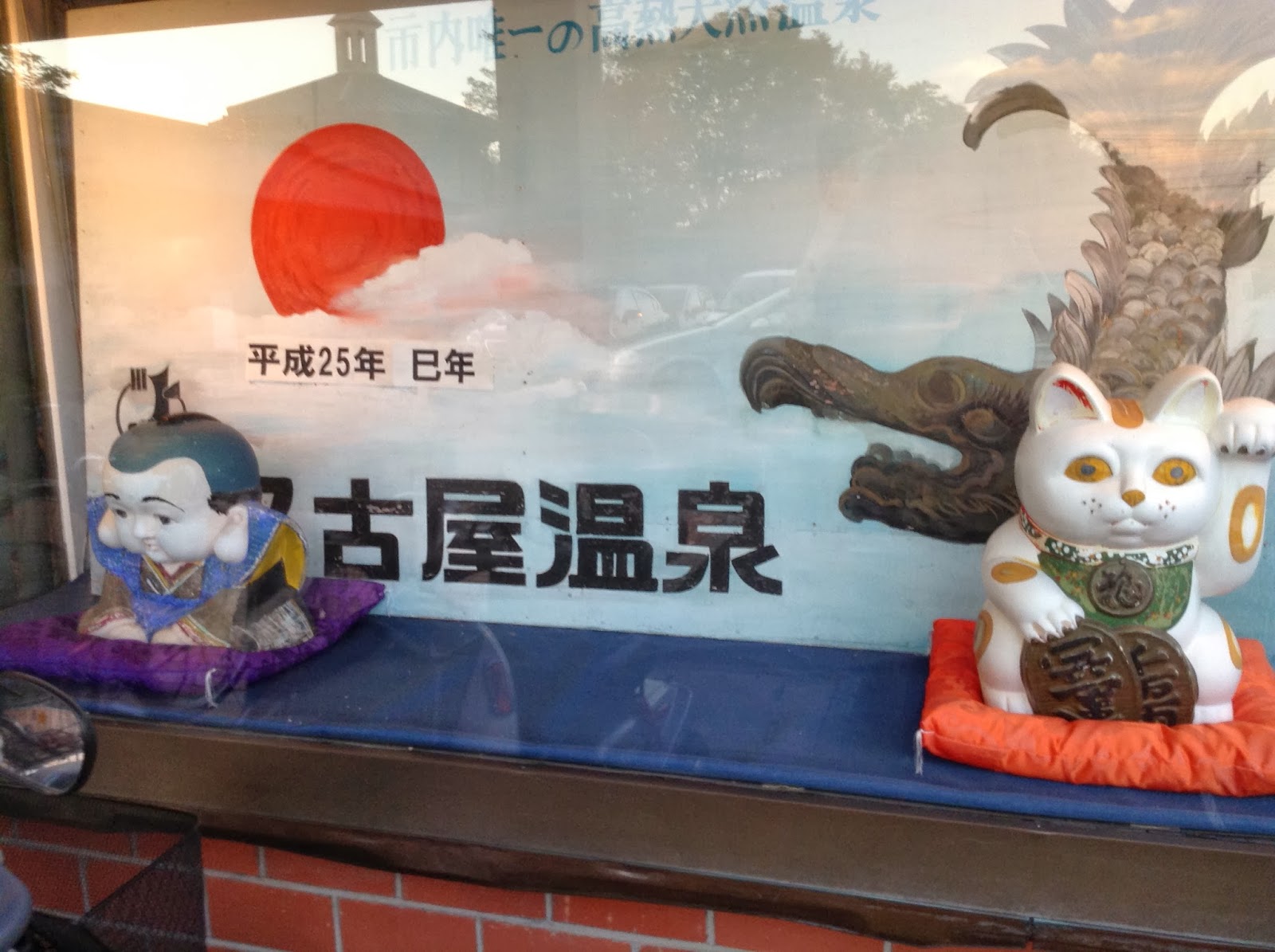Big Hot Spring in Nagoya, Dainagoyaonsen (大名古屋温泉)
 |
| Welcoming Figures at the Entrance to Dainagoyaonsen |
I walked alongside the extremely large bath and estimated the size to be larger than a professional tennis court. The size shocked me. For the last few months my onsen trips have been to hot springs in remote mountains, but I was visiting Nagoya, the third largest city in Japan, and city onsen are often extremely different from their country cousins. Unfortunately, I was unable to take photographs inside the bathing area.
The immense bath is partitioned into different bathing experiences. One corner has metal panels just under the water line. Electric jolts were emanating from the panels. The closer you sit to a panel, the stronger the sensation became. The electricity makes your muscles quiver in controlled spasms, which some people swear feels great. I find it unnerving. These the electric baths are called denkiburo (電気風呂).
Close to the electric bath was a section in which thousands of air bubbles were ascending to the surface from holes in a one-meter square metal plate. The bubbles are said to stimulate the skin cells. The section with super strong jacuzzi jets of hot water that pummeled my stiff muscles into soft pudding gave me the greatest satisfaction. There is also an outdoor hot spring in a small roofless courtyard in the middle of the building.
If bathing with lots of strangers is not your cup of tea, you can rent a private bath for you, your family, or friends. These private baths are called kashikiriburo (貸切風呂). The charge is 2,500 yen (about 25 US dollars) for an hour. You can extend the time at a discounted rate, too.
This onsen facility can handle hundreds of people at the same time. The building has several stories with various rooms. There are tatami rooms for relaxing on the floor after bathing. The small restaurant's prices are very low (look at the picture), and the typical Japanese dishes that I saw looked tasty.
Next to the restaurant is a huge karaoke room with a display of ancient Japanese armor. I guess that bad singers need the armor.
Therapeutic massages are available in small rooms. A 30 minute massage costs 2,300 yen (about 23 US dollars), a 60 minute massage is 4,500 yen (about 45 US dollars), and the price of a 90 minute massage is 6,800 yen (about 68 US dollars).
If you need to park young children somewhere safe while you are relaxing in a massage, singing karaoke, or sleeping in one of the rest rooms, there is an play room for kids. It is stocked with all sorts of video games and other amusements.
A hotel is also on the premises. One night with two meals and access to the onsen facility is 10,500 yen per person (about 100 US dollars). Rooms for day use are also available.
Despite the scale of the onsen building, there was a sense of community that I felt when I observed people interacting. Of course many were strangers, but I saw numerous bathers greeting others as if they had known each other for many years. Dainagoyaonsen feels like a place where many neighbors meet and discuss local events. Onsens exist for many reasons, and this one seemed to function, despite the scale of the building, as a place for neighbors to gather to share news and to keep in touch. It was nice to see this traditional way of relating to each other still in existence in one of Japan's largest cities. The staff members also enthusiastically welcome and try to assist foreigners who do not speak Japanese.
Admission charges vary: Adults pay 750 yen from the opening time of nine in the morning until four in the afternoon. After four, the charge is 550 yen. The hot spring closes on Monday.
Getting there is a walk of around minutes from Hatta Station. A Japanese map, which is from the onsen's website is at the end of this post. The URL is http://www.dainagoyaonsen.com/.
There is another hot spring in Nagoya that I prefer. Ryusenji-no-yu (竜泉寺の湯) has baths and special rooms where the heat rises from hot rocks on the floor.These special rooms are called Ganbanyoku (岩盤浴). The international airport in Nagoya also has a great bath. You can soak while watching planes land and depart, an unusual experience indeed!





0 Response to "Big Hot Spring in Nagoya, Dainagoyaonsen (大名古屋温泉)"
Post a Comment